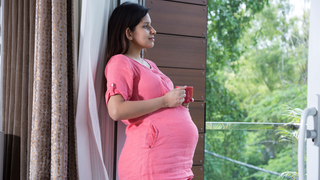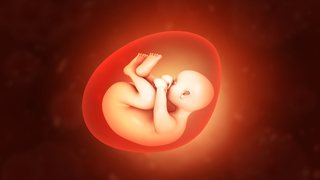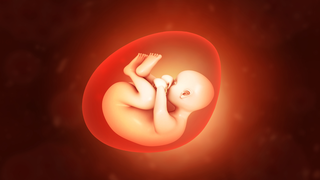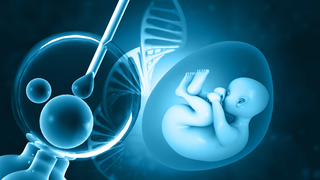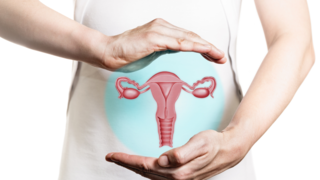
Week 10 of Pregnancy

Key Takeaways at Week 10
- Their cute face is developing from today, and their eyes may and will remain closed for safety until about week 26
- There's a lot going on right now that you can't see, such as the first signs of what will become a beautiful toothy smile growing under the gum line, but they won't surface until your baby is around six months old
- That small belly is also getting active, creating digestive juices, the critical organs have developed, the kidneys are producing more urine (though nothing compared to what you'll be dealing with when you eventually meet), and in the case of males, testosterone is being produced as early as week 10
- Your first prenatal appointment has most likely already taken place (or will happen this week). In addition to an early ultrasound (and hearing and seeing the baby's heartbeat!), your doctor may suggest nuchal translucency screening and non-invasive prenatal testing. Both test for chromosomal abnormalities
- Your child's brain now accounts for 43% of their weight! The hypothalamus, which controls systems like body temperature and heart rate, develops in week 10
- If you are in Week 10 of your pregnancy you are in your first trimester and in the third month
- 30 more weeks remaining in your pregnancy
Baby's Development at Week 10
Week 10 of pregnancy is a milestone. Baby is no longer an embryo; they are now a foetus. These two phrases merely represent distinct stages of growth. The embryonic period involves the formation of key organs such as the brain, heart, and lungs, as well as the arms and legs. Once a foetus is created, its organs and components begin to grow and develop. At this stage, the baby's head has gotten rounder and accounts for around half of its total length. Their forehead has a little protrusion to allow their brain to grow properly.By this point, the baby's hands and feet have completely developed, with longer fingers and toes and the beginning of nail development. They can flex their elbows for the first time with functional arm joints, and cartilage and bones are developing. Fingernails and hair are also beginning to emerge! And can you believe your baby is practicing swallowing and kicking within your 10-week pregnant belly?
- Baby Weight- Around 4-5 grammes
- Baby Length- 1 and 2 inches long
- Baby Size- Strawberry or a green olive
Pregnancy Symptoms and Body Changes This Week
As the baby develops, your ligaments and muscles begin to stretch within your abdomen, your breasts expand, and other significant changes may occur. Here are some of the most common symptoms:- Round ligament discomfort: Don't be shocked if you start experiencing aches and pains in your abdomen as it expands to accommodate your developing baby. While some expectant mothers don't understand or recognise them, others find these feelings, known as round ligament discomfort, to be quite uncomfortable. If you're pregnant with twins, round ligament discomfort may be more obvious. Inform your OB if your pain is severe or if you are concerned about your symptoms.
- Growing breasts: By week 10 of pregnancy, your breasts have most likely grown in size and become uncomfortable from weeks of preparation for nursing!
- Morning sickness: Nausea and vomiting are frequent during this time, although they don't always happen in the morning. The good news is that they will most likely lessen once you reach the second trimester.
- Mood swings: Hormonal fluctuations may be the cause of this emotional roller coaster.
- Fatigue: Not only is your body working very hard to develop a baby, but your sleep may be interrupted by some bizarre nightmares.
- Increased vaginal discharge: An increase in blood flow to your vagina, along with a rise in oestrogen production, might result in more of the clear, odourless discharge known as leukorrhoea. It may seem a bit nasty, but this material is only nature's method of eliminating microorganisms. However, if it is coloured, contains blood, has a terrible odour, or causes pain, see your doctor. These might be indicators of something else.
- Visible veins: Those blue streaks are a crucial reminder: they represent all of the additional blood flowing in your body to support your developing baby! Spider veins may also occur as a result of the increased blood flow in your veins.
Body Changes in Week 9
You are most likely experiencing distinct pregnancy symptoms about two and a half months into your pregnancy. You'll most likely feel fatigued, achy, and hormonal. You may feel enthusiastic about the changes your body is experiencing at times, but you may also feel irritated. All of this is absolutely normal.Everyone is waiting for the baby's first telltale flutter. Even though the baby is practising kicks, you won't feel a foetus move until the second trimester since the kicks and movements are too subtle at this point. Even if you can't feel it yet, you may love seeing the baby kick during the ultrasound!
Because there are so many changes, scents might irritate you. Some of the fragrances you adored previously, may now disgust you.
Nausea and vomiting, as well as constipation and gas, are still possible at this phase.
As the small bump grows more visible, you'll want to grab your camera and take your first baby belly photographs.
Many experts suggest that pregnant women with a normal BMI gain between up to 2kgs during the first trimester. So you're on track if you've gained a few kgs.
If you're pregnant with twins, your doctor may advise you to gain half a kg each week throughout the first half of your pregnancy, which means you may have gained about 4 kg by the time you're 10 weeks along. But don't panic if you haven't gained much weight or have lost weight due to morning sickness. When the nausea subsides in the second trimester, you should be able to regain some weight.
10 Week Ultrasound
If you've decided to opt for genetic testing, 10 weeks is usually a good time to do so. Genetic testing is optional; the choice to have it or not is totally up to you; however, a genetic counsellor can help you make an educated decision based on your family history and risk factors.The nuchal translucency screening (also known as the NT Scan) takes place between weeks 10 and 14, and it checks your foetus for the possibility of Down syndrome and numerous other chromosomal abnormalities. You'll undergo a painless ultrasound, and the baby's nuchal fold (back of the neck) will be assessed for abnormalities. The NTS is often performed as part of a "First Trimester Screen," which includes blood testing and a risk assessment based on the findings of both the ultrasound and the blood test.
A cell-free foetal DNA test, commonly known as a non-invasive prenatal test (NIPT), is a blood test conducted at week 10 or later. It examines the mother's blood for evidence of Down syndrome, Edward Syndrome, Patau Syndrome, and other chromosomal abnormalities. Other more invasive procedures, including CVS and amniocentesis, may also be performed to discover problems. They are usually conducted if you have a greater probability of having a baby with a chromosomal abnormality, either due to family history, risk factors, or NTS or NIPT findings.
The CVS (chorionic villus sampling), which is conducted between weeks 10 and 13, utilises an ultrasound to locate the placenta. The doctor next uses ultrasound as a guide to introduce a needle into your belly or vagina while doing a speculum inspection to harvest cells from the placenta. The cells are examined for genetic abnormalities.
Your Baby Bump at Week 10
Your belly is probably just beginning to show. That's because your baby is still growing rapidly, and your belly has begun to acquire an additional curve. You may not appear pregnant to those you meet, but you may need elastic waistline jeans and loose-fitting blouses around this time.Everyone shows differently, and your baby bump will vary depending on your body shape and size, as well as the shape of your uterus. If this isn't your first pregnancy or you're carrying multiples, you're more likely to have a noticeable baby bump in the first trimester. If you aren't appearing pregnant now, just be patient, your tummy will swell with time.
Tips for Week 10
Being 10 weeks pregnant is a significant milestone for both you and your baby. Here's some additional professional advice on how to transition to this new stage while keeping you and your baby safe.- During this period, aim for 30 minutes of activity every day. If you're having problems sticking to your normal workout plan, try adding yoga (with your doctor's consent). It may help you sleep better, relieve pregnancy-related problems, and even prepare you for breathing methods to use during delivery
- You're creating a whole new individual, so be sure to take your prenatal vitamins and eat vitamin-rich meals. Vitamins A, C and D are very crucial, as are folic acid, DHA, iron, calcium, and potassium
- Exhaustion, dizziness, mood swings, and intense responses to odours, tastes, or sights are among the symptoms of pregnancy at 10 weeks. Your body is rapidly changing, and you are bombarded with hormones. This implies that your symptoms might range from minor to severe. Allow your body to tell you when to relax or slow down. Most of these symptoms should subside quickly
Checklist for Week 10
- Schedule a nuchal translucency screening
- Schedule your CVS test (if you choose to get one)
- Make a dental appointment—it's crucial to remain on top of your oral hygiene
- Shop for looser-fitting garments
Frequently Asked Questions on Week 10 of Pregnancy
- Can you feel the baby at ten weeks?
Even though the baby is practising kicks, you are unlikely to feel a 10-week-old foetus move until the second trimester since the kicks and movements are just too subtle to detect at this early stage. Even if you don't feel it yet, you may still enjoy seeing the baby kick during the ultrasound! - How much water should I consume at this stage of pregnancy?
Throughout your pregnancy, you'll need to drink more fluids to maintain your increased blood volume, baby's circulation, and amniotic fluid levels. Aim for 8 to 12 glasses of water each day, and drink whenever you can. Keep a big pitcher of water in the fridge or carry a water bottle with you as a reminder to hydrate.

